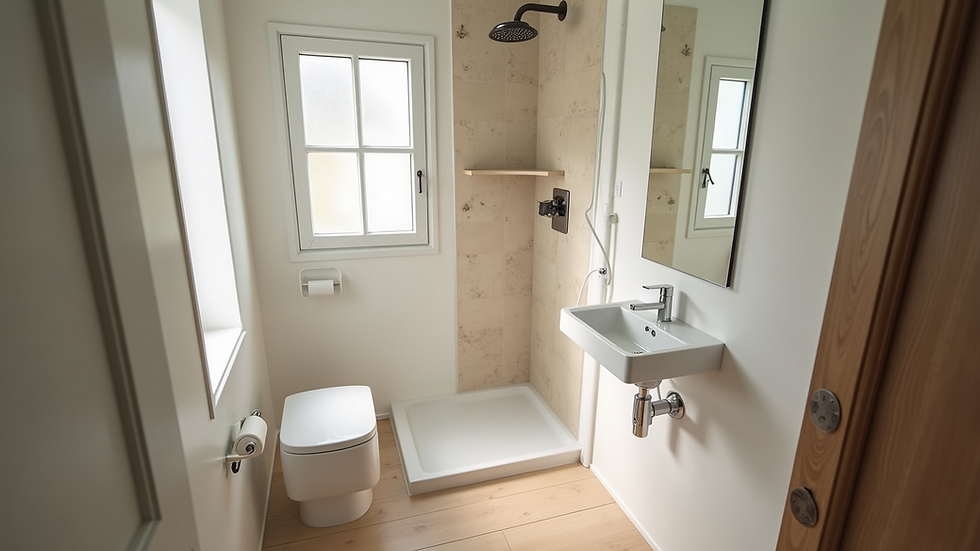Empowering Accessibility, Affordability, and Independence: Discover the potential of Tiny Homes for Disability Living in Ithaca.
- Santana for Common Council

- Jun 28
- 4 min read
As the tiny home movement gains momentum, especially in vibrant settings like Ithaca and New York, it brings fresh possibilities for individuals with disabilities. This charming college town is renowned for its emphasis on sustainability, inclusivity, and progressive living solutions. Tiny homes stand out as a powerful tool for creating accessible living options that meet the needs of those with disabilities. This blog post explores how these compact spaces can redefine housing in Ithaca, highlighting their significant benefits and opportunities.
Rethinking Housing with Tiny Homes
Traditional housing often overlooks the diverse needs of individuals with disabilities. Space limitations, conventional designs, and high prices can pose significant obstacles. Tiny homes, usually measuring between 100 to 400 square feet, provide a new perspective. They can adhere to accessibility standards while maintaining style and comfort.
Imagine entering a cozy space with zero-step entrances, making it easy for someone using a wheelchair to come and go. Thoughtful design can include open floor plans and accessible storage solutions, enabling residents to navigate their homes comfortably. For example, ensuring that kitchen counters are at wheelchair height can empower individuals to cook independently.

Tiny homes prioritize simplicity and efficiency, reimagining what it means to live well. By focusing on accessible features, these homes can greatly enhance the quality of life for residents.
Benefits of Tiny Homes for Disability Living
1. Affordability
In Ithaca, living costs can be overwhelming, especially for those on fixed incomes or relying on disability benefits. Tiny homes provide a more feasible housing option. For example, the average cost of a tiny home can range from $30,000 to $60,000, compared to traditional homes that can command upwards of $250,000. Lower construction and utility costs mean that tiny homes can offer significant savings.
These smaller spaces also translate into lower monthly utility bills—reports indicate that tiny home owners can save up to 75% on energy costs compared to standard homes. This financial flexibility is crucial for supporting independence and personal goals, allowing residents to manage their finances more effectively.
2. Customization for Individual Needs
Each person has unique accessibility requirements. Tiny homes can be easily customized to accommodate specific needs.
Features such as wheelchair ramps, walk-in showers, and smart technology can be tailored to suit individual residents. For example, having voice-activated lights can make navigating a home easier for someone with mobility challenges. Builders are increasingly using innovative and aesthetic designs, ensuring that each home reflects the occupant's distinct desires and needs, ultimately fostering a sense of pride and comfort.

3. Community and Support
The tiny home movement is about more than physical spaces. It cultivates a sense of community. Ithaca features initiatives that promote inclusive living, where tiny homes can be clustered together. This setup creates supportive networks that empower residents.
Living close to others who understand shared experiences can combat isolation. Communities designed with accessibility in mind tend to thrive on collaboration, resource sharing, and mutual support. A collective living environment allows individuals with disabilities to encourage one another in their daily lives, building a stronger sense of belonging.
Sustainability and Advocacy
1. An Eco-Friendly Approach
Because of their smaller size, tiny homes are naturally more eco-friendly. Residents benefit from lower energy and resource consumption. By integrating energy-efficient appliances, solar panels, or even composting toilets, tiny homes can advocate sustainable living.
For instance, tiny home dwellers can have up to a 20% reduced carbon footprint compared to traditional households. This eco-friendly living fosters a sense of connection to nature and enables individuals with disabilities to contribute positively to the environment.
2. Advocacy for Accessible Housing Policies
As the idea of tiny homes gains traction for disabilities living in Ithaca, advocacy becomes vital. Engaging local policymakers and community planners is essential to facilitate more inclusive housing options.
Advocates can promote awareness concerning the specific needs of individuals with disabilities. Collaborating with local organizations can help secure support for more accessible housing policies. This collaborative effort ensures that tiny homes are built into Ithaca’s housing future, creating a community that truly values inclusivity.
A Bright Future for Tiny Homes in Ithaca
The potential for tiny homes catering to disabled living in Ithaca is promising. By focusing on accessibility, affordability, and independence, these well-designed spaces can significantly improve the quality of life for individuals with disabilities.
Through community engagement, personalized design, and steadfast advocacy, Ithaca can set an example in establishing a supportive and inclusive environment. Tiny homes are more than just places to live; they represent a renewed sense of autonomy and opportunity.

Whether you are a resident, an advocate, or just curious about housing's future, considering tiny homes for disability living in Ithaca can spark meaningful change. They inspire independence and strengthen community bonds. The tiny home for disabled individuals' movement is just beginning—join the conversation and be part of this exciting journey! Let's start the conversation, get in touch with Alejandro Santana, call/text 607-262-3230



Comments